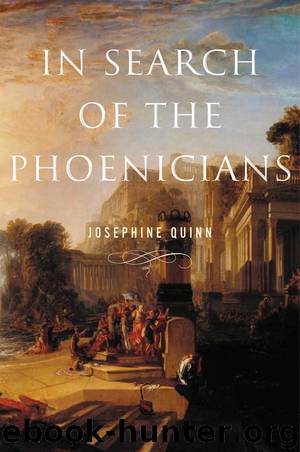In Search of the Phoenicians by Quinn Josephine;

Author:Quinn, Josephine;
Language: eng
Format: epub
Publisher: Princeton University Press
Published: 2017-09-19T16:00:00+00:00
9.2 Frederic Leighton, Phoenicians Bartering with Ancient Britons (1894–95), a fresco painted for the Royal Exchange in London.
This comparison of migrant, maritime peoples was also popular in the newly nationalist scholarship on the Phoenicians that I discussed in Chapter 1. At the end of the nineteenth century, George Rawlinson announced in his History of Phoenicia that the Phoenicians were “the people who of all antiquity had most in common with England and the English” as well as “the first who discovered the British islands.”89 In France, the less flattering comparison with Carthage continued to play a large part in understandings of the English: in their 1885 volume on Phoenician and Cypriot art, Georges Perrot and Michel Chipiez discuss how the “English of Antiquity” preserved their power by means very similar to “those that England has used for the last two centuries to establish and maintain, with a handful of soldiers and thousands of ships, her vast colonial empire.” They continue, however: “The difference is that Tyre never tried to conquer and govern the peoples living in the lands whose coasts she visited”—a policy that, they explain, Carthage would have done better to follow—and then declare that “England has followed the policy of Tyre when circumstances have not, as they have in India and South Africa, led her further than she wanted to go.”90 The excellent English translation of the work published in the same year averts its eyes here, noting simply that “England has followed the policy of Tyre wherever she could.”91
Occasional examples of the Phoenician settlement hypothesis continue to surface even today,92 but from the later nineteenth century, the growth of anti-Semitism helped to suppress the appetite for comparisons between the British and Phoenicians, who were increasingly associated both with the Jews and with the practice of child sacrifice highlighted in Gustave Flaubert’s hugely successful 1862 novel Salammbô.93 The discovery of the pre-Greek scripts of Linear A and B on Crete was one of the final nails in the coffin of nineteenth-century “Phoenicomania”: no longer could the Phoenicians be celebrated as the first great literate civilization of the Iron Age Mediterranean.94
PHOENICIAN IRELAND
In Ireland, unlike in Britain, the Phoenicians were not an alternative to medieval legends but an addition to them. Since the medieval search for national origins among the sons of Noah began, Irish works such as the Lebor Gabála Érenn (The Book of the Taking of Ireland) of around 1100 CE had presented one of the ancestors of the Irish Gaels as Míl the Spaniard, whose ancestors originated in the eastern Mediterranean and were descended from Japheth, son of Noah. They were often associated with Scythia, and before the “discovery” of Indo-European (a model for understanding the development of languages that only became generally accepted in the nineteenth century), all Celtic languages were generally thought to have descended from Scythian.95
This Scythian connection was a relatively neutral one in the Irish texts, but contemporary British authors, picking up on descriptions in Greco-Roman writers of the Scythians as a primitive
Download
This site does not store any files on its server. We only index and link to content provided by other sites. Please contact the content providers to delete copyright contents if any and email us, we'll remove relevant links or contents immediately.
| Anthropology | Archaeology |
| Philosophy | Politics & Government |
| Social Sciences | Sociology |
| Women's Studies |
Mysteries by Colin Wilson(3257)
People of the Earth: An Introduction to World Prehistory by Dr. Brian Fagan & Nadia Durrani(2623)
Ancient Worlds by Michael Scott(2504)
Foreign Devils on the Silk Road: The Search for the Lost Treasures of Central Asia by Peter Hopkirk(2393)
The Memory Code by Lynne Kelly(2286)
The Splendid and the Vile by Erik Larson(2235)
Lost Technologies of Ancient Egypt by Christopher Dunn(2125)
The Earth Chronicles Handbook by Zecharia Sitchin(2106)
Come, Tell Me How You Live by Mallowan Agatha Christie(2032)
The Plantagenets by Dan Jones(1935)
Last Chance to See by Douglas Adams(1856)
The Return of the Gods by Erich von Daniken(1844)
Wars of the Anunnaki by Chris H. Hardy(1633)
Keeper of Genesis by Graham Hancock(1544)
Before the Dawn by Nicholas Wade(1534)
The Cygnus Mystery by Andrew Collins(1474)
The Message of the Sphinx by Graham Hancock(1439)
Fragile Lives by Stephen Westaby(1368)
Hieroglyphs: A Very Short Introduction by Penelope Wilson(1272)
